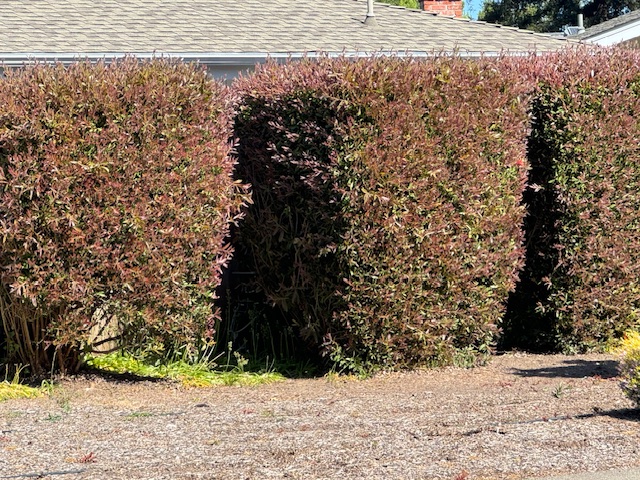Dodonea — commonly called hopseed bush — is a genus of evergreen shrubs and small trees known for their colorful foliage, with leaves that can range from green to purple, red, or bronze depending on the species and cultivar. The leaves are often small and lance-shaped, giving the plant a delicate and ornamental appearance.
In spring and summer, Dodonea plants produce clusters of small flowers in shades of green, yellow, or pink. The flowers are not particularly showy but can add a subtle touch of color to the plant. These flowers are followed by small, papery fruits that contain tinyseeds.
Dodonea plants typically have a bushy, rounded growth habit and are often used in landscaping for their ornamental appeal. Dodoneas are typically easy to grow and maintain, tolerating a variety of soil types and growing conditions. They can be used as ornamental shrubs in gardens, borders, and hedges, and some species are also suitable for use as screening plants or windbreaks. They are also drought-tolerant once established, making them a popular choice for xeriscaping projects.
Dodoneas belongs to the family Sapindaceae. They are native to Australia, New Zealand, and some Pacific islands.

Get to know Dodonea – Hopseed bush
- Plant type: Evergreen shrub or small tree
- Growing zones and range: Zones 8 to 12
- Hardiness: Leaves will be burnt by frost
- Height and width: 10 to 18 feet tall and 6 to 12 feet wide
- Foliage: Narrow obovate leaves vary from green to burgandy
- Flowers: Tiny, inconspicuour flowers followed by lime green seed capsules
- Bloom time: Spring and summer
- Uses: Border, hedge, screen, windbreak, slopes
- Common name: Hopseed bush
- Botanical name: Dodonea viscosa
- Family name: Sapindaceae
- Origin: Australia, New Zealand, and some Pacific islands
Where to plant Dodonea – Hopseed bush
- Plant Dodonea in a sunny location: Dodonea prefers full sun but will grow in partial shade. Dodonea prefers 6 to 8 hours of sunlight per day.
- Plant Dodonea in well-draining soil.Dodonea plants do not like to sit in waterlogged soil. Make sure to plant them in soil that is well-draining to prevent root rot.
- Dodonea plants prefer sandy or loamy soil that is rich in organic matter.
When to plant Dodonea – Hopseed bush
- Set container-grown Dodonea outdoors in spring or fall.
Planting and spacing Dodonea – Hopseed bush
- Space Dodonea plants 6 to 12 feet apart.
- Dig a hole that is slightly larger than the plant’s root ball then the set the plant in place with the crown of the plant just slightly higher than the surrounding soil and backfill with soil. Water the plant thoroughly after planting to help establish root growth.

How to water and feed Dodonea – Hopseed bush
- Dodonea grows best in soil that is consistently moist but not waterlogged, especially during the growing season.
- Until established, water Dodonea plants regularly, especially during hot and dry periods.
- Dodonea is drought tolerant once established, but for the first few months after planting, make sure to water regularly to help the plant establish a strong root system.
- Dodonea plants do not require a lot of fertilizer. Use a balanced slow-release fertilizer once a year in the spring to encourage healthy growth.
Dodonea care – Hopseed bush
- Prune Dodonea plants as needed to maintain shape. Dodonea plants can tolerate heavy pruning to maintain their shape and size.
- Prune Dodonea in the spring before new growth begins.
- Mulch around the base of Dodonea to help retain moisture and suppress weeds.
Dodonea pests and diseases – Hopseed bush
- Dodonea plants are relatively pest and disease-resistant, but keep an eye out for any signs of trouble and treat as necessary.
- Watch for common garden pests like aphids and spider mites. Treat any infestations promptly to prevent damage to your Dodonea plant.
- Keep an eye out for signs of root rot or leaf spot.

Dodonea propagation – Hopseed bush
- Dodonea can be propagated from seeds or cuttings. Collect seeds in late summer or early autumn and sow them in a well-draining potting mix.
- You can propagate Dodonea plants by taking stem cuttings in the spring or summer. Dip the cuttings in rooting hormone and plant them in a well-draining soil mixture.
Dodonea varieties to grow – Hopseed bush
- Dodonea microzyga, called brilliant hop seed bush, is a spreading shrub that grows 3 to 10 feet tall; has finely cut leaves and showy red fruits.
- D. viscosa, called hopseed bush or hop bush, grows 10 to 15 feet tall and spreads as wide; can be trained to tree form by cutting out all but one single stem; willow-like green leaves to 4 inches long; inconspicuous flowers in spring or summer followed by pappery seed capsules; a popular cultivat is ‘Purpurea’, called purple hop seed bush, has rich-purple-bronze leaves.















